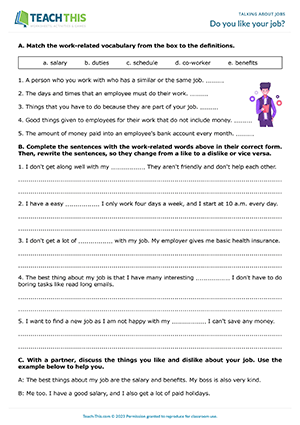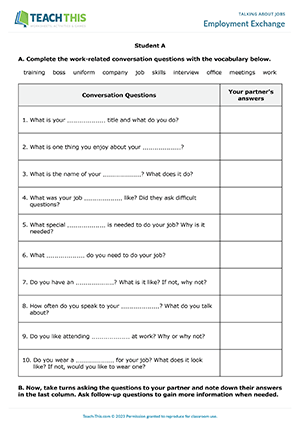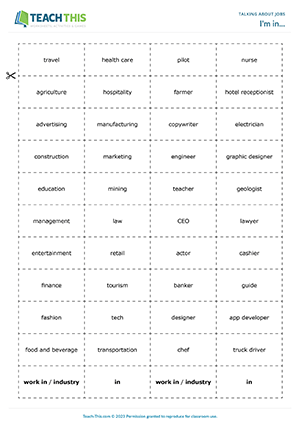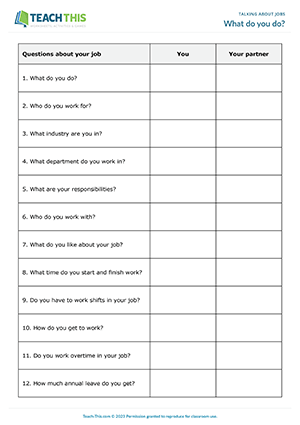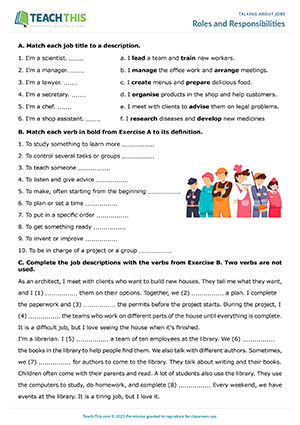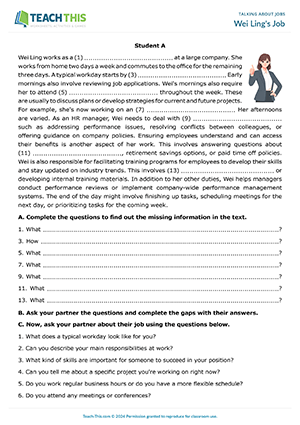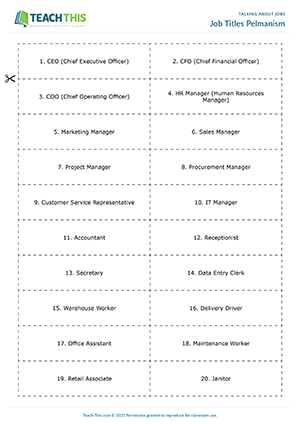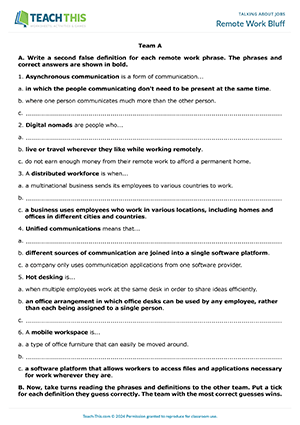Here is a free work preferences worksheet and speaking activity to help students talk about what they like and don't like about their jobs. First, students match work-related vocabulary to definitions. Students then complete sentences with the work-related words in their correct form. Next, students rewrite the sentences, so they change from a like to a dislike or vice versa. Students then discuss the things they like and dislike about their jobs with a partner. After that, students take part in a Find someone who activity where they go around the class asking each other questions about work likes and dislikes. When a classmate answers 'yes' to a question, the student writes down their name and asks a follow-up question to gain more information. Afterwards, students give feedback to the class on what they found out.
In this useful talking about jobs activity, students practice work-related vocabulary by completing conversation questions with the words provided and then asking and answering the questions with a partner. Working alone, students complete work-related conversation questions with the vocabulary provided. Students then take it in turns to ask each other the conversation questions, noting down their partner's answers. Afterwards, students report back to the class on the things they found out about their partner's job.
In this productive talking about jobs game, students match industries to jobs and form sentences with the phrases I'm in... and I work in the ... industry. In pairs, students take turns turning over one industry card and one job card. If the industry matches with the job (e.g. health care and nurse), the student picks up a phrase card from the pile and forms two sentences using the cards, e.g. 'I'm in health care. I'm a nurse', or 'I work in the health care industry. I'm a nurse.' The student then keeps the two cards and has another turn. If the two cards don't match, the student turns them back over, keeping them in the same place. The student with the most pairs of cards at the end of the game wins. After reviewing the correct answers, students practice forming sentences about their own jobs and industries using the two phrases.
Here is an engaging talking about work activity that students can use to practice common questions about jobs and work. First, dictate the 12 questions about work from the worksheet to the class, saying each question twice. When the dictation is complete, students check their answers using the worksheet. After reviewing the questions, students answer them by writing complete sentences in the column marked 'You'. Next, in pairs, students take it in turns to ask and answer the questions, noting down their partner's answers in the last column. Finally, students report back to the class on what they found out about their partner.
This comprehensive job descriptions worksheet helps students learn and practice common verbs used to describe job roles and responsibilities. To begin, students match job titles to their descriptions. Next, students match the verbs in bold from Exercise A to their definitions. Students then complete job descriptions with the verbs. Afterwards, each student is given two job cards. Students then write descriptions for the two professions using verbs from a box. When the students have finished, they read out their descriptions to the class, who tries to guess which job is being described.
In this talking about jobs information gap activity, students practice asking and answering questions about work-related roles and responsibilities. First, in two groups, students complete work-related questions to find out missing information in a text about someone's job. Next, students pair up with someone from the other group and take turns asking and answering the questions, completing the text with their partner's answers. After that, students compare their texts to check the answers. Lastly, students discuss their jobs by asking and answering similar work-related questions with their partner.
Here is an enjoyable job titles game to help students review and practice common job titles used in companies. In groups, students take it in turns to turn over one job title card and one job description card. If the job title matches the description, the student reads them both out aloud, keeps the two cards and has another turn. If not, the student turns them back over, keeping them in the same place. The game continues until all the cards have been matched. The student with the most pairs of cards at the end of the game wins.
In this industry vocabulary worksheet, game and activity, students learn words and phrases for talking about industry and then ask and answer related discussion questions. First, students complete definitions with industry vocabulary from a box. Students then use the industry-related vocabulary to complete discussion questions. Next, students use the discussion questions in a pelmanism game where they match the questions to example answers. In pairs, players take turns turning over one question card and one answer card. If the question and answer match, the player keeps the cards and has another turn. If not, the player turns the cards back over, keeping them in the same place, and play passes to the other student. The player with the most pairs of cards at the end wins the game. Lastly, pairs use the question cards to discuss their industry or an industry they know well.
In this fun remote work vocabulary game, students create false definitions for phrases related to remote working and then play a game where they guess which remote work definition is correct. In competing teams of two, students create a second false definition for each remote work phrase on their worksheet. When both teams have finished, they take turns reading out each phrase and the three definitions to the other team, who guess which definition is correct. If the other team guesses the correct definition successfully, the team puts a tick next to the remote work phrase. The team with the most correct guesses at the end of the game wins.
Latest Free
Resources
- Everyday Objects Bingo
Everyday Objects
Elementary (A1-A2)
- Action Verb Races
Actions
Elementary (A1-A2)
- Birthday Basics
Birthdays
Elementary (A1-A2)
- Sales Phrasal Verbs
Business Phrasal Verbs
Upper-intermediate (B2)
Latest Member
Resources
- Collocations at Work
Business Collocations
Intermediate (B1)
- Etiquette Trivia Board Game
Etiquette and Manners
Upper-intermediate (B2)
- Everyday Objects Vocabulary
Everyday Objects
Pre-intermediate (A2)
- Let's have a talk
Verb-Noun Collocations
Pre-intermediate (A2)



